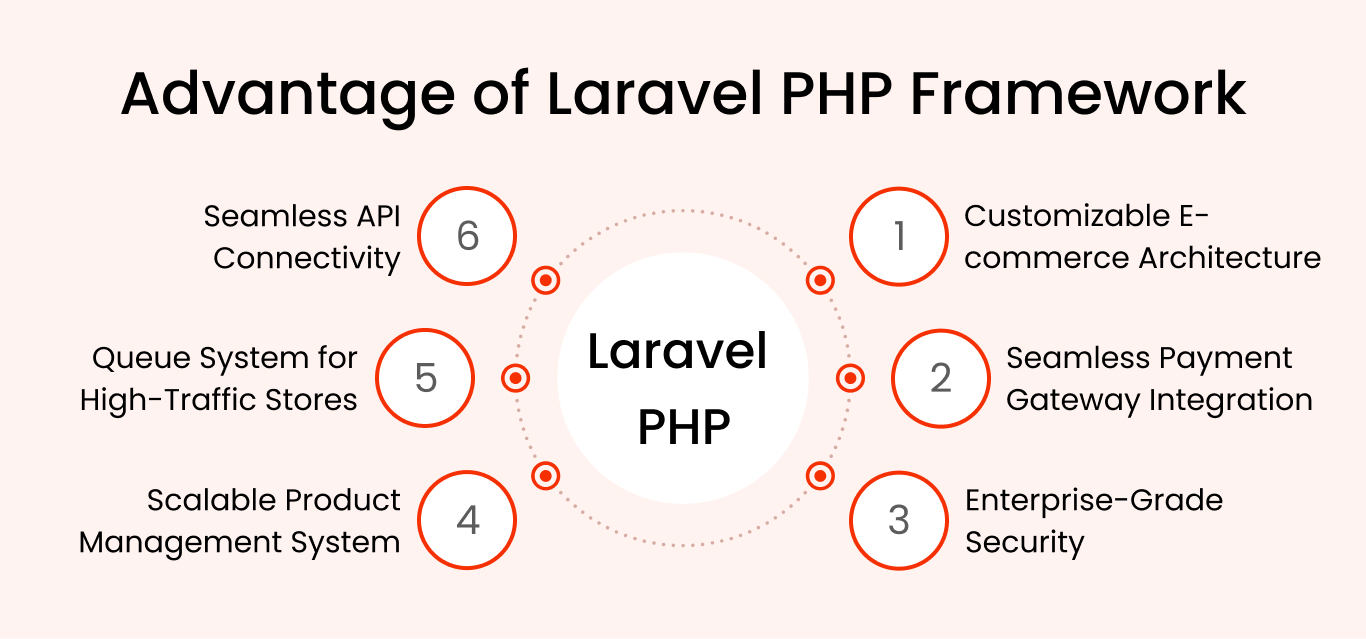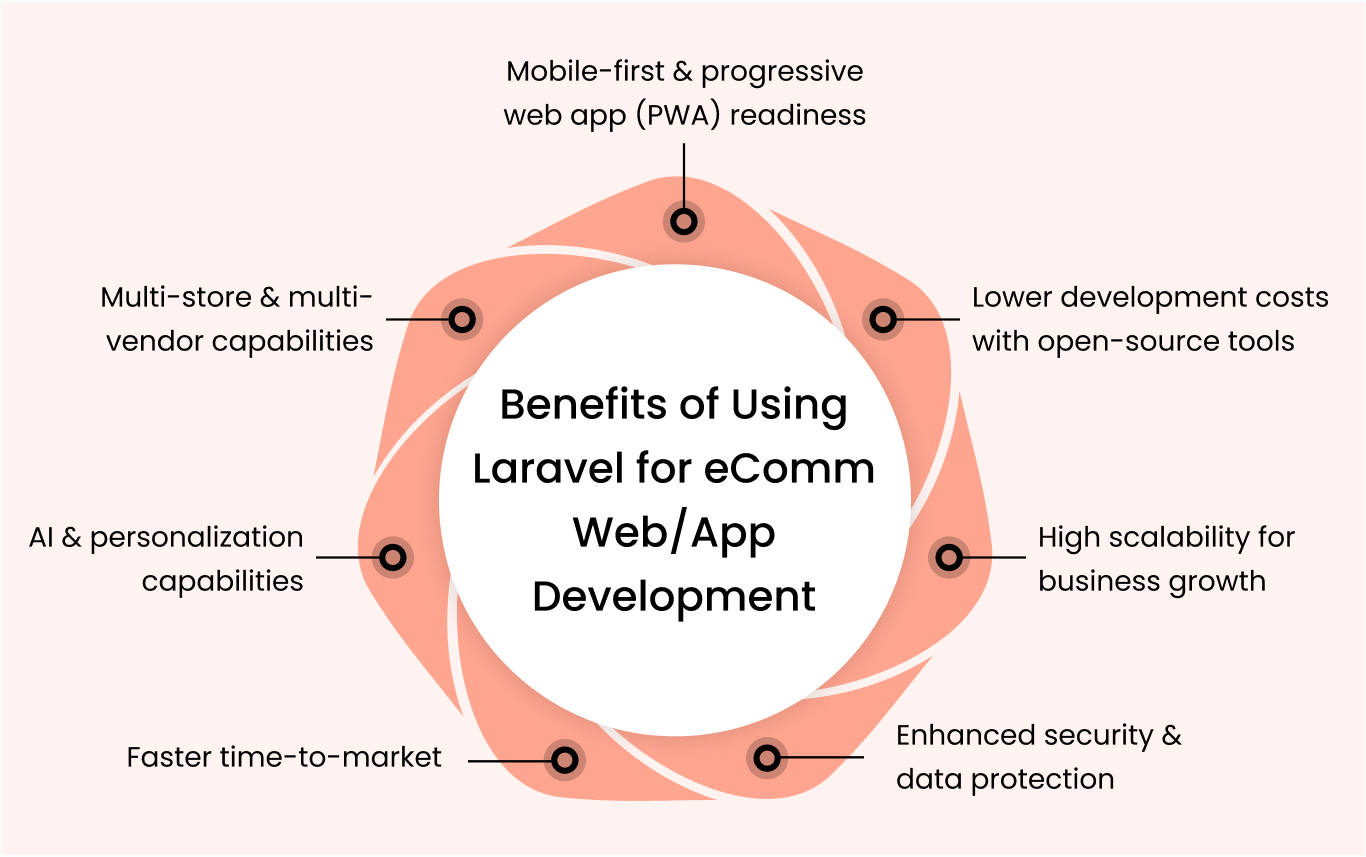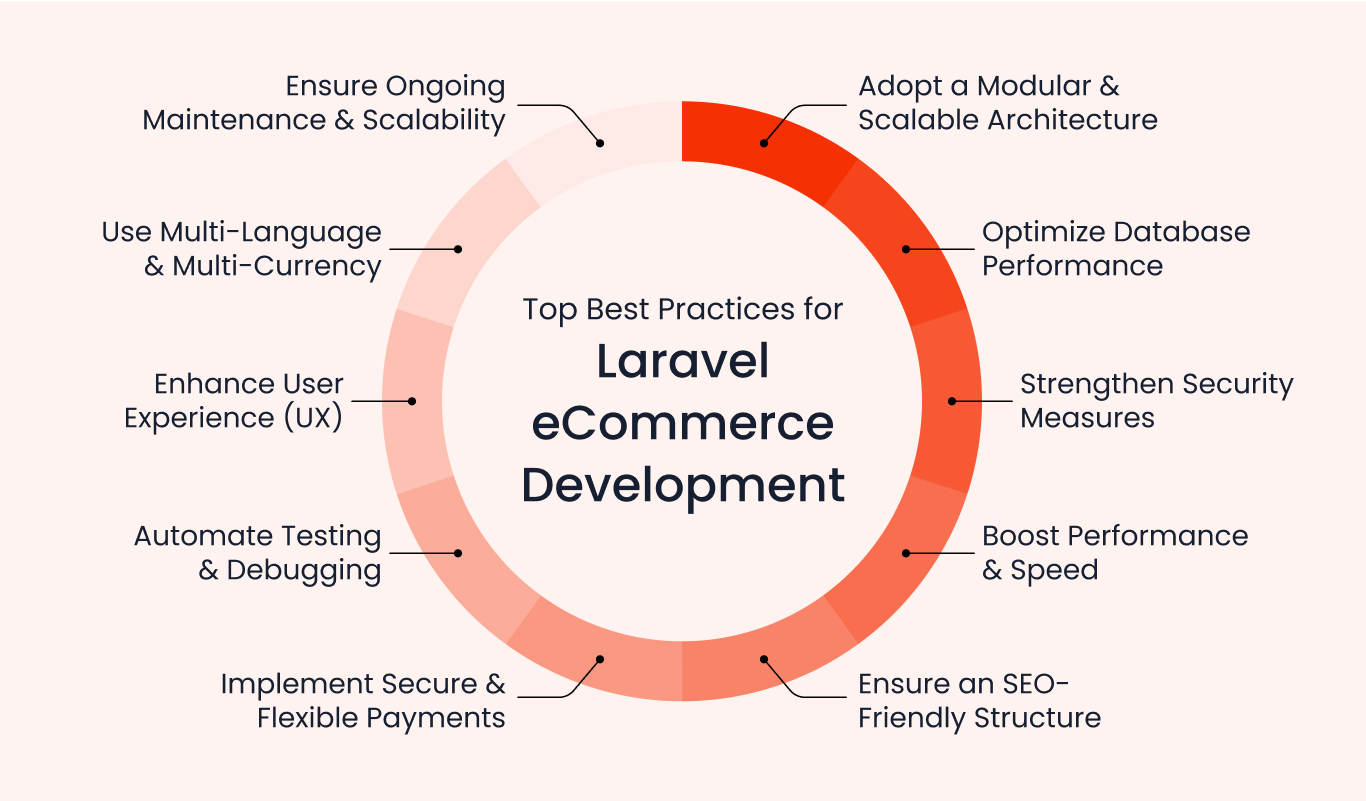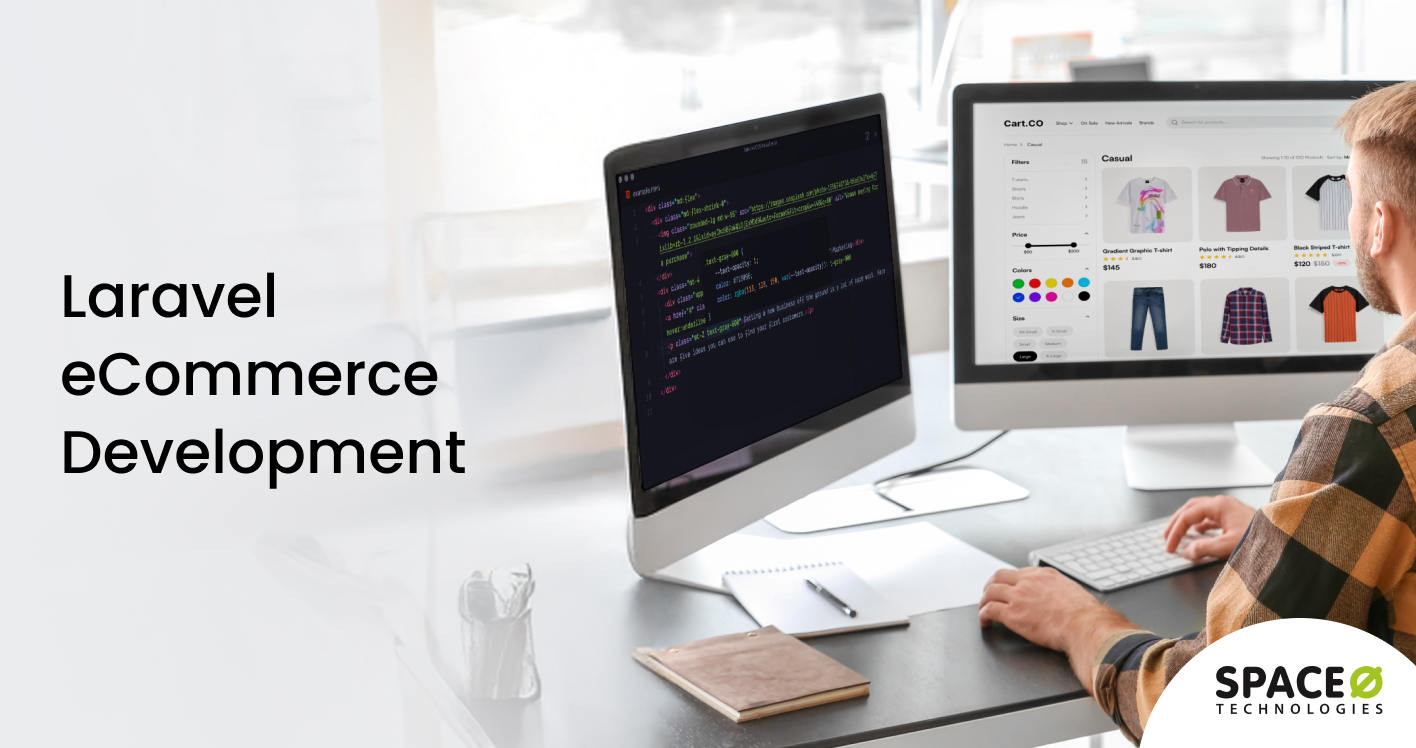Contents
Running an eCommerce store should be seamless. But if your current eCommerce platform feels more like an obstacle than a tool for growth, it’s time to rethink your approach.
Many eCommerce websites have hidden limitations, such as rigid customization, slow performance, or weak security. These roadblocks affect more than just the user interface and shopping cart functionality, they also impact the customer experience and revenue.
If your existing eCommerce site is slowing you down or you’re looking to build a new project, it’s time to change with Laravel eCommerce development.
Laravel is built to eliminate these challenges and empower businesses with a flexible and secure foundation for their eCommerce solutions. Many startups and enterprises are shifting toward Laravel development services for web development, including eCommerce websites, enterprise solutions, content management systems (CMS), and mobile app backends.
This guide will explore Laravel’s pivotal role in eCommerce development and provide a comprehensive, step-by-step roadmap to build custom Laravel eCommerce platforms.
Introduction to Laravel PHP Framework
Laravel is an open-source PHP framework for building modern web applications. It follows the Model-View-Controller (MVC) architecture, which ensures better code organization, scalability, and maintainability.
What sets Laravel apart is its developer-friendly environment and powerful built-in features. Eloquent ORM simplifies database interactions using an intuitive Active Record pattern. The Blade Templating Engine allows developers to create dynamic views efficiently. The PHP Artisan CLI automates repetitive tasks, making the development process smoother and more efficient.
Laravel’s security is a significant strength. It has built-in CSRF protection, encrypted data storage, and secure authentication mechanisms. Developers also benefit from advanced tools like Laravel Mix for asset compilation, Laravel Queues for background processing, and Laravel Passport for API authentication.
Importance of Laravel in developing e-commerce websites

When it comes to eCommerce development, Laravel offers a developer-friendly framework with built-in features like seamless database management, powerful authentication, and efficient caching. These capabilities enable businesses to develop online stores with strong security and customizable functionalities.
- Customizable E-commerce Architecture: Laravel’s modular system allows businesses to build tailored eCommerce solutions with reusable components.
- Seamless Payment Gateway Integration: Laravel supports secure transactions with Laravel Cashier, Stripe, PayPal, and other third-party payment gateways.
- Enterprise-Grade Security: Laravel ensures user data remains protected through SQL injection prevention, authentication scaffolding, and advanced encryption.
- Scalable Product Management System: Using Eloquent relationships and PHP Artisan Migrate, businesses can efficiently manage product catalogs, categories, and inventory.
- Queue System for High-Traffic Stores: Laravel’s queue management system processes background tasks without slowing down the shopping experience.
- Seamless API Connectivity: Laravel’s API–ready architecture allows businesses to integrate their eCommerce sites with mobile apps, third-party tools, and ERP/CRM systems.
Laravel powers eCommerce development with its modern framework, streamlining the building of dynamic online stores. Offering tools like Eloquent ORM, Blade templating, and robust routing simplifies database interactions and view management. With built-in security and caching, Laravel helps create responsive platforms that grow alongside your business.
Laravel adoption in 2025: Usage stats that show its e-commerce potential
Laravel has emerged as one of the most widely used open-source PHP frameworks for web application development. It offers scalability, security features, and developer-friendly tools.
The Laravel ecosystem continues to expand, with a strong developer community and extensive Laravel eCommerce packages that enhance its capabilities. Here are the latest Laravel usage statistics according to Trends.BuiltWith, TechJury, and Growjo reports.
- Over 2.5 million websites have been built using Laravel globally, showcasing its wide developer adoption and ecosystem maturity.
- Laravel’s annual revenue of $5.7 million in 2024 isn’t just a financial milestone—it speaks volumes about the framework’s health and potential benefits.
- The estimation of annual revenue is currently $23.3M per year, which is a huge number to consider when considering this framework for your e-commerce needs.
- Around 1.72 million websites have previously used Laravel, underscoring its consistent adoption and industry trust.
- Currently, 859,186 websites are live on Laravel eCommerce platforms.
- Additionally, 535,215 domains redirect to Laravel-powered sites.
7 Benefits of Choosing Laravel eCommerce Development

For businesses planning to launch an online store, Laravel provides an affordable and efficient framework that meets modern development needs. Here are the top 7 benefits of using Laravel for online store development.
Lower development costs with open-source tools
Laravel’s open-source nature significantly reduces development costs. With its vast ecosystem of pre-built tools, libraries, and community support, businesses can accelerate the web development process without heavy investments in custom solutions. Choosing the top Laravel development companies further ensures expert execution while keeping costs in check.
High scalability for business growth
Laravel enables seamless scalability, allowing your eCommerce site to grow as your business expands. Whether you’re handling hundreds or millions of transactions, Laravel’s robust architecture ensures smooth performance without compromising speed or security. Laravel applications support evolving business needs, making them ideal for long-term eCommerce development.
Enhanced security & data protection
Security breaches can cost businesses millions. Laravel provides built-in security features like SQL injection prevention, CSRF protection, and secure authentication mechanisms, ensuring your eCommerce store is safeguarded against cyber threats and fraud. Hire Laravel developers to benefit your businesses with a highly secure eCommerce platform designed to protect sensitive customer data.
Faster time-to-market
Laravel’s MVC (Model-View-Controller) architecture and pre-built functionalities reduce development time. It helps businesses to launch their online stores faster and gain a competitive edge in the market. Laravel’s efficient installation process, extensive documentation, and dedicated community support ensure smooth project execution without unnecessary delays.
AI & personalization capabilities
Laravel supports seamless integration with AI-driven tools to help businesses implement personalized shopping experiences, recommendation engines, and chatbots. These features enhance customer engagement, boost conversions, and provide a great shopping experience across the e-commerce website.
Multi-store & multi-vendor capabilities
Laravel allows businesses to manage multiple stores or vendors under a single platform, making it ideal for marketplaces and large-scale eCommerce operations. Its ability to integrate essential e-commerce development features, such as a shopping cart and payment processing, makes it a preferred choice for businesses building scalable e-commerce sites.
Mobile-first & progressive web app (PWA) readiness
With mobile commerce dominating online sales, Laravel makes it easy to develop mobile-responsive eCommerce sites and PWA solutions to provide an optimized shopping experience across devices. Laravel applications are built using PHP frameworks, making them highly adaptable for web development and integrating payment gateways for eCommerce stores.
Upgrade Your eCommerce Store with Laravel PHP Framework
Partner with us, and our Laravel developers will enhance your site’s speed, security, and user experience.

Step-by-Step Guide for Laravel eCommerce Development

Building an eCommerce platform requires careful planning and the right tools. With integrated middleware for authentication, session management, and testing, Laravel equips you to make an online store that meets modern development standards. Here’s a step-by-step guide to building an e-commerce site using Laravel.
Set up the Laravel project
A strong foundation is key to a successful eCommerce project. Laravel provides a robust framework with built-in features that streamline development.
Install prerequisites
Ensure you have the following installed on your system:
- PHP 8.1 to 8.2 (as required by Laravel 12)
- Composer (dependency manager for PHP)
- Node.js & NPM (for asset compilation and CSS/JS handling using Vite)
Create a Laravel project
Run the following command to create a new Laravel project:
composer create-project laravel/laravel your-project-nameNavigate to your project directory
cd your-project-nameConfigure environment variables
Set up database credentials and application settings in the .env file:
DB_CONNECTION=mysql
DB_HOST=127.0.0.1
DB_PORT=3306
DB_DATABASE=your_database_name
DB_USERNAME=your_database_user
DB_PASSWORD=your_database_password
Install frontend dependencies & compile assets
Laravel 12 uses Vite for front-end asset bundling. Install dependencies using:
npm installFor development mode, run
npm run devFor a production build, use the below command
npm run buildRun the development server
Start the Laravel server using:
php artisan serveYour Laravel eCommerce project is now set up and ready for further development.
Design database
A well-structured database is crucial for efficiently managing products, users, and orders.
Essential tables & relationships
Define tables for:
- Products, Categories, Users, Orders, and Payments
- Establish many-to-many (Products & Categories), one-to-many (Users & Orders), and one-to-one (Orders & Payments) relationships.
Create migrations
Run the following command to generate migrations for each table:
php artisan make:migration create_products_table
php artisan make:migration create_categories_table
php artisan make:migration create_users_table
php artisan make:migration create_orders_table
php artisan make:migration create_payments_table
Modify the generated migration files in the database/migrations/ to define columns and relationships.
Run migrations
Once the migration files are updated, execute the following command to create the tables in your database:
php artisan migrate
Utilize eloquent ORM
Laravel’s Eloquent ORM simplifies database interactions by allowing you to define models and relationships efficiently.
With the database structure in place, you’re ready to move to the next step in building an eCommerce website.
Develop models, views, and controllers
Following the MVC architecture ensures a clean and scalable codebase.
- Models: Define data structures and business logic.
- Controllers: Handle user requests, process data, and return responses.
- Views: Use Blade templates to present data dynamically.
Design routing and URLs
Routing helps define how users navigate through your store.
- Clear URL Structure: Use descriptive URLs (/products, /cart).
- Route Parameters: Capture dynamic values like product IDs (/product/{id}).
- Laravel’s Routing System: Map routes to controllers for efficient request handling.
Implement authentication and user management
Secure authentication ensures user safety and access control, allowing seamless login, registration, and account management.
Install Laravel Breeze (Simple Authentication)
Laravel Breeze provides a lightweight authentication system with registration, login, password reset, and email verification. Install it using the following commands:
composer require laravel/breeze –dev
php artisan breeze:install
npm install && npm run dev
php artisan migrate
This will set up authentication views, routes, and controllers.
User registration & login
Laravel Breeze simplifies user authentication with ready-to-use registration and login functionality.
Account management
- Allow users to update profiles, manage addresses, and track orders.
- Store and retrieve user details securely using Laravel’s Eloquent ORM.
Security features
- Email Verification: Ensure users verify their emails before accessing critical functionalities.
- Password Reset: Implement a secure password reset mechanism.
With authentication, your eCommerce platform can now handle user accounts securely.
Build a product catalog and shopping features
The product catalog is the core of your eCommerce site.
- Product Listing: Display products with filters and sorting options.
- Product Details: Provide detailed descriptions, reviews, and related items.
- Search Functionality: Help customers find products quickly.
Checkout and payment integration
A seamless checkout process improves conversion rates.
- Address Selection & Payment Methods: Offer payment options like Stripe and PayPal.
- Order Confirmation & Security: Ensure transactions are encrypted and secure.
- Fraud Protection: Implement fraud detection measures.
Order management and admin panel
A robust admin panel simplifies store management.
- Order Tracking & Updates: Manage order statuses and notify customers.
- Inventory Management: Monitor stock levels and automate updates.
- Reporting & Analytics: Generate insights into sales performance.
Testing and deployment
Thorough testing ensures a smooth user experience before launch.
- Unit & Feature Testing: Test individual components and complete workflows.
- Security Testing: Identify vulnerabilities before deployment.
- Deployment Strategies: Use Git, Laravel Forge, or Vapor for a streamlined launch.
Building an e-commerce store with Laravel requires a structured approach. Following these steps will help you create an innovative and adaptable online store that effectively meets business objectives and customer expectations. If you want to speed up the development process and leverage expert skills, you can also consider outsourcing Laravel development to trusted professionals for better efficiency and faster results.
Common Challenges in Laravel eCommerce Development & Their Solutions
We have analyzed various developer podcasts, interviews, industry reports, and one-on-one sessions with experts to filter the top challenges in eCommerce development. Below, we highlight the most common challenges along with practical solutions.
| Challenges | Description | Solution |
|---|---|---|
| Performance Optimization | Slow load times can lead to poor user experience and lost sales on an ecommerce platform. | Implement caching (Redis, Memcached), optimize database queries, and use load balancing for better performance. |
| Security Concerns | Protecting sensitive user data and transactions is crucial for a secure, seamless shopping experience. | Use built-in security features like CSRF protection, encryption, and API authentication. Professional software development services ensure compliance. |
| Scalability Issues | As an e-commerce project grows, handling more traffic and products becomes challenging. | Optimize database indexing, use cloud hosting, and adopt microservices architecture for scalability. |
| Complex Payment Gateway Integration | Multiple payment methods require secure and efficient handling to enhance the seamless shopping experience. | Use built-in payment solutions and third-party integrations like PayPal, Stripe, and Razorpay while ensuring security compliance. |
| Search and Filtering Performance | Users expect fast and accurate product searches on an ecommerce platform. | Implement advanced search tools like Algolia or Elasticsearch for better search results and filtering. |
| Managing Third-Party APIs and Plugins | Integrating multiple APIs can slow down the site and cause dependency issues. | Use API rate limiting, queue systems, and caching to optimize API performance. A software development team ensures smooth API management. |
| Customization and Maintenance | Businesses require unique features that need regular updates and maintenance. | Follow modular coding practices, use admin panel solutions, and document code for easy future upgrades. |
| Deployment and Hosting Challenges | Managing CI/CD, hosting, and server setup can be complex. | Use automated deployment tools and cloud hosting solutions to simplify the process and improve uptime. |
eCommerce development requires a strategic approach to tackle performance, security, scalability, and optimization challenges. Businesses aiming for success should invest in expert development to ensure a high-performing, user-friendly, and future-proof platform.
If you are considering developing an e-commerce app or website, working with an experienced e-commerce development company can provide significant advantages. Their expertise in building robust and scalable eCommerce projects ensures that your platform is optimized for both performance and long-term success.
10 Best Practices to Adopt for Laravel eCommerce Development

Laravel is a powerful framework for eCommerce development. Its design supports efficient performance even as business demands evolve, making meeting current and future customer expectations easier. Below are some key best practices for Laravel development for eCommerce businesses.
- Adopt a Modular & Scalable Architecture: Break down your application into reusable components that can be easily managed and enhanced as your business evolves.
- Optimize Database Performance: Fine-tune queries and structure your data efficiently to handle high traffic and large volumes of transactions.
- Strengthen Security Measures: Implement CSRF protection, validate input, encrypt sensitive data, and follow Laravel’s security recommendations to safeguard sensitive data and mitigate potential threats.
- Boost Performance & Speed: Streamline code and utilize caching strategies to ensure your online store responds quickly to user interactions.
- Ensure an SEO-Friendly Structure: Design your site architecture and URLs to improve search engine visibility and attract organic traffic.
- Implement Secure & Flexible Payments: Integrate trusted payment gateways that support various transaction methods for a smooth checkout process.
- Automate Testing & Debugging: Use automated tools to check for errors regularly, ensuring consistent performance and high code quality.
- Enhance User Experience (UX): Focus on intuitive design and clear navigation to keep customers engaged and encourage repeat visits.
- Use Multi-Language & Multi-Currency: Cater to a global audience by integrating language localization and currency conversion features.
- Ensure Ongoing Maintenance & Scalability: Establish routines for regular updates and improvements, ensuring your platform can evolve with market demands.
Top 3 eCommerce Platforms Built Using Laravel PHP Framework
Due to its architecture, high-level security, and extensive customization options, Laravel has become a preferred framework for building eCommerce websites. Businesses across various industries leverage Laravel to create seamless online shopping experiences, integrate advanced functionalities, and ensure smooth operations.
Bagisto
Bagisto is an open-source eCommerce platform built entirely on Laravel. It offers features like multi-store inventory management, SEO tools, and advanced cart functionalities, making it highly popular for businesses starting from scratch.
Parts Express
Parts Express is a feature-rich eCommerce marketplace developed using Laravel. It provides advanced search and filtering, multi-vendor support, secure payment gateway integration, and real-time order tracking. The platform is designed to deliver a seamless shopping experience, making it an ideal choice for businesses looking to establish a scalable and efficient online marketplace.
Material.sa
Material is a Laravel-based eCommerce platform built specifically for selling construction supplies. It includes a user-friendly interface, bulk ordering system, automated inventory management, and seamless vendor integration. With its robust architecture, Material simplifies procurement and ensures smooth transactions, making it a reliable solution for the construction industry.
These examples highlight how Laravel is effectively utilized in the eCommerce industry to build efficient and feature-rich platforms. With its flexibility and extensive ecosystem, Laravel enables businesses to create customized solutions that enhance user experience and streamline operations.
After exploring all these benefits, it’s natural to start thinking about hiring a Laravel developer. But if you’re unsure about the costs involved or worried about unexpected expenses — we’ve got you covered! To simplify your hiring journey, we’ve put together a comprehensive guide on the cost of hiring Laravel developers. This guide breaks down everything you need to know — from region-wise rates to potential hidden charges — so you can plan your budget with confidence and avoid any surprises along the way.
Is Laravel the Right Choice for Your eCommerce Business?
Laravel stands out as a reliable framework for eCommerce development. It offers the ability to handle growth, robust measures to protect your platform, and an architecture designed for smooth, efficient online shopping experiences. Its modular design and extensive customization options make it an excellent choice for businesses building a next-generation eCommerce platform.
For those focused on Laravel development for eCommerce businesses, following best practices and leveraging Laravel’s rich ecosystem can help you create a fast, user-friendly online store. Whether you are launching a new platform or upgrading an existing one, Laravel provides the flexibility to meet your business needs.
Looking to Build a Future-Ready eCommerce Platform with Laravel?
Contact us to build a custom Laravel eCommerce platform that adapts to your growing needs and delivers a seamless online shopping experience.
FAQs About Laravel eCommerce Store Development
FAQs About Laravel eCommerce Store Development
Is Laravel suitable for large-scale eCommerce websites?
Yes, Laravel is highly scalable and can handle large product catalogs, high traffic, and complex business operations. With features like queue management, database optimization, and caching, Laravel ensures smooth performance even for enterprise-level eCommerce sites.
How long does it take to build an eCommerce store using Laravel?
A basic Laravel eCommerce store can be completed in 4-6 weeks, while a fully customized eCommerce website may take 2- 6 months. The website development process depends on project complexity, custom features, and third-party integrations.
How much does it cost to develop a Laravel eCommerce website?
A basic eCommerce site with essential functionalities like product listings, cart, and checkout can cost between $5,000 and $15,000. A mid-level store with custom UI/UX, third-party integrations, and enhanced security may cost $50,000. Enterprise-grade solutions with advanced features, multi-vendor support, AI-driven recommendations, and high scalability can exceed $100,000.
How to create e-commerce in Laravel?
To build an eCommerce website using Laravel, follow these key steps:
- Install Laravel and set up the Laravel development environment.
- Configure database tables and implement product management features.
- Integrate shopping cart functionality for a smooth user interface.
- Set up payment services to process payments securely.
- Optimize your eCommerce solution with SEO-friendly features and caching.
- Deploy your Laravel project on a reliable eCommerce platform.
How secure is a Laravel eCommerce website?
Laravel has strong security features, including CSRF protection, authentication, encryption, and SQL injection prevention. These features ensure that customer data and transactions remain safe from threats like cross-site scripting (XSS).
Can I integrate third-party services like payment gateways in Laravel?
Absolutely! Laravel supports seamless payment processing by integrating major payment gateways like PayPal, Stripe, Razorpay, and Authorize.net. Developers can also use Laravel Cashier to manage subscriptions and recurring payments.



